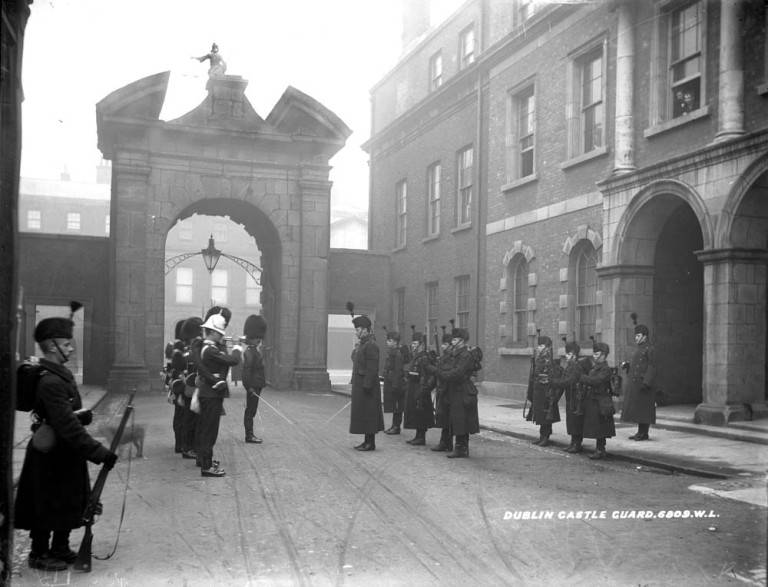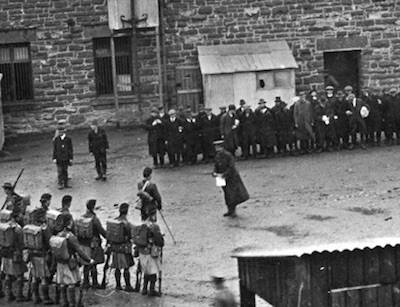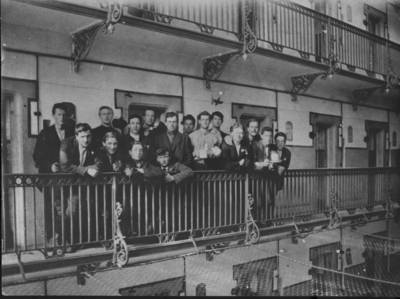The Places of Detention, by Dr William Murphy
The autograph books that can be viewed on this website originate among prisoners (some of them convicts, others internees) who were held at a series of places of detention during the years 1916 to 1918.
Dublin Castle Hospital was a product of the First World War. In December 1914, as more and more wounded soldiers arrived in Dublin from the front, a proposal emerged to augment the available medical facilities by converting the ceremonial apartments at the Castle (including the Throne Room) into a hospital. A committee was established, funds were raised, and the Board of Works carried out the necessary conversion works. Royal Army Medical Corps doctors, around sixty nurses, and Red Cross personnel staffed the hospital.

In 1916, the casualties that accumulated during the Rising were cared for at a range of military and civilian hospitals across city, including the hospital at Dublin Castle. According to A. Kinsella, in addition to 118 soldiers, 20 civilians and 2 police constables, the staff there treated 34 injured rebels. Among these was James Connolly, who had received a serious leg wound. Harry Colley, who was operated on for serious wounds, remembered, ‘We were treated very well . . . though in the early stages it was evident that many of the nurses looked upon us as rioters or gangsters’. He also reminisced of exercising in the Castle gardens in fine weather. Similarly, Dan McCarthy, later President of the GAA, recalled that Surgeon Haughton, in whose care he was placed, was ‘most attentive to me’ though he was a Unionist. Unlike Colley and McCarthy, who were interned in Britain after their recovery, Cathal Brugha was so severely wounded that he was released when deemed well enough to leave hospital in August 1916.
In the aftermath of the Rising more than 2,000 men were transferred for internment in Britain using provisions of the Defence of the Realm Act (DORA). They were distributed to eight prisons or detentions centres under the control of the War Office: these places were Knutsford, Wakefield, Wandsworth, Woking, Lewes, Barlinnie, Perth and Stafford. The five women interned were sent to a civil prison at Lewes. At first, while considering the internees’ future treatment, the authorities imposed rigorous regimes in these places. The internees were not allowed to send or receive letters, or to receive visitors. A silent regime was imposed and they had very little exercise. Their diet was basic and could not be augmented from the outside. In late May, these regimes were considerably relaxed. The internees were allowed to send and receive letters, to receive parcels, food and visitors. Then too they could communicate; immediately they began to organize themselves and their daytime hours.
Among the several hundred held at Stafford Jail (near Birmingham) were Michael Collins, Darrell Figgis (who recounted his experiences there in a memoir, A Chronicle of Jails), James Ryan, and Patrick Colgan. An original prison building, dating from the late eighteenth century, was still in use there in 1916 but the Irish internees were held in two more modern buildings called the New Prison and the Crescent. In his statement to the Bureau of Military History, Colgan described it as ‘a most forbidding place’ though like many of those held there he praised the ‘kindness’ of Fr Moore, a local Catholic priest who came into the prison to act as chaplain to the Irish internees.
Some weeks after the introduction of the improved regime Fr Moore, ‘with tears in his eyes’, came to Figgis and said ‘They’re taking the men away from me.’ This process was underway at all the prisons where male internees were held. The authorities had decided upon an internment camp at Frongoch, near Balla, in north Wales, and, beginning on 9 June, began to transfer the great majority of the male internees there. This took some time but at its peak, in mid-July, c.1800 internees were in custody there. In fact, Frongoch consisted of two camps. The ‘south camp’ was a disused distillery that had been converted into dormitories and other facilities (originally for prisoners-of-war), while in the ‘north camp’ there were twenty-seven large huts, some of which acted as dormitories and some of which served religious, recreational, or medical purposes.

Internees had very different recollections of the place, including of the conditions there, but the judgment of the historian Seán McConville seems fair: ‘the camp was Spartan rather than inhumane’. The internees had a good deal of freedom to organize their own lives inside the wire, and a camp culture emerged based around games, entertainments, classes and training. The bonding effect of the experience for the internees has been emphasized in much of the literature. Seán O’Mahony and Lyn Ebenezer sub-titled their books ‘University of Revolution’ and ‘The Birth of the IRA’. McConville was a little more restrained but even he sub-titled his chapter on the subject ‘a training camp in Wales’. It is important to remember, however, that there were divisions among the internees between a militarist cohort and others who had been less radical prior to their internment and were not radicalized by the experience. By September, following the release of many of those considered less dangerous, the camp population had been reduced to a more aggressive cohort of around 540. Increasingly, in the months that followed, they and the camp authorities came into conflict. This, however, came to an end in the days before Christmas when all the internees were released.
One hundred and forty male rebels and one female rebel remained in prison in Britain that Christmas: the men at Lewes prison and the woman, Constance Markievicz, at Aylesbury prison. They were different because they were not interned but had been tried by court martial in Dublin after the Rising. Following conviction they were held at Mountjoy prison in Dublin, but soon all the men were transferred to England: 65 and 57 penal servitude prisoners to Dartmoor and Portland prisons respectively, and 18 men, who had received shorter hard labour sentences, to Wormwood Scrubs. In these places they experienced the full rigours of the relevant convict regimes. Then, on 14 November, following political pressure from Ireland, the Home Secretary, Herbert Samuel, announced that he intended collecting the male convicts at one prison where they would be granted an improved regime. This included visits, more frequent letters, and some freedom to associate among themselves. This was delivered in December when the men were gathered at Lewes.
Beginning in March 1917, the convicts there became more assertive under the leadership of Eamon de Valera, Thomas Hunter and Thomas Ashe. First, they began to defy the authorities in apparently small matters, culminating, at the end of May, in a riot. This forced the authorities to break up the group by sending some to Maidstone, Parkhurst, and Portland prisons. It was also while at Lewes that Joe McGuinness was elected MP for South Longford on the slogan ‘Put him in to get him out’. In mid-June those still held at Lewes, and all the other convicts, were released in an apparent attempt to create an atmosphere of goodwill for the forthcoming Irish Convention.
By the middle of September 1917 a new cohort of forty or so Irish Volunteer prisoners (convicted under DORA, mostly for illegal drilling) had accumulated at Mountjoy prison, Dublin. This included a group from Clare, led by three brothers Michael, Paddy and Austin Brennan, who had decided to drill, get convicted, and then hunger strike. Several veterans of Lewes, among them Thomas Ashe and Austin Stack, were also there. Holding political prisoners in a large group involved risks that had become evident at Lewes. Nonetheless, the authorities at Dublin Castle had decided to bring all these convicts to Mountjoy, rather than scatter them around Ireland’s prisons, because Mountjoy was the largest prison in the country and because, in the event of a hunger strike, it had good medical facilities.
Mountjoy opened in March 1850. It was modeled on Pentonville prison, opened in London in 1842, and it was designed to employ a variant of the ‘separate system’ that was used at Pentonville. Originally, there were 496 cells in four wings, arranged like the spokes of a wheel. In 1858 the complex grew when a separate female convict prison was built. The General Prisons Board of Ireland (GPB) managed both from the establishment of that body in 1878. As Tim Carey’s history of the prison demonstrates, Mountjoy’s role within the system changed several times in the succeeding decades but by 1917 it was the convict and local prison for Dublin. In the year 1917-1918, the daily average number of prisoners held there was 192 men and 113 women.
On 20 September 38 of the Irish Volunteer prisoners began a hunger strike, demanding political prisoner or prisoner-of-war treatment, terms they used interchangeably. The strike resulted in the death of Thomas Ashe, the abandonment of forcible-feeding during hunger strikes in Irish prisons, and the concession of an ameliorated regime to the prisoners. In the immediate aftermath, the authorities also decided to remove any DORA prisoners, who were in receipt of the new regime, to Dundalk prison where they could be isolated from other prisoners.
In 1916 Dundalk prison had been one of the twelve local prisons in Ireland outside of Dublin. Built in 1853 to replace an older, smaller gaol in the town, by the year 1916-1917 Dundalk had 125 ordinary cells (in two wings) but the daily average number of prisoners (all men) was a mere 39. In these circumstances the GPB closed it. Now, however, it was re-opened and re-staffed under the governorship of Patrick McHugh. On 13 November McHugh received, from Mountjoy, 64 Irish Volunteer prisoners. These included most of those who had participated in the recent hunger strike and newer convicts, including 20 Dublin-based volunteers, each serving sentences of three months for drilling offences. Unfortunately for McHugh, they immediately began a hunger strike, claiming that the agreement they had reached at Mountjoy had been broken. Over the next five or six days all of these prisoners were released.

For several months Irish prisons were afflicted by a ’hunger-strike mania’ as group after group of Irish Volunteer convicts secured their release using the tactic. In late February 1918 the authorities decided that this would have to stop and so they faced prisoners on hunger strike with a decision: stop or starve. This, combined with a new agreement in mid-March regarding an improved regime, worked. Dundalk was once more designated the special holding centre for prisoners entitled to this new agreed regime. By the end of March, however, it was full and the female wing of Belfast prison, on the Crumlin Road, was also set aside for such prisoners. The female prisoners were moved to Armagh prison to facilitate this.
Belfast prison was built in the mid-1840s and received its first prisoners in 1846. In 1918 it was another of the twelve local prisons outside of Dublin and its large female wing had 155 ordinary cells. There remained c.440 cells for the use of ordinary male prisoners on the other wings. At least 227 Defence of the Realm Act convicts, who qualified for the improved regime, many of them serving short sentences, arrived at Belfast prison between 11 April and 28 June 1918. Then the 95 men on the DORA wing, led by Austin Stack and Joe MacDonagh, began to a campaign of noisy disruption. As the women’s wing ran along the road, the prisoners’ protests attracted attention from outside and generated loyalist demonstrations on the Crumlin Road. When the governor, William Barrows, decided to move the men to a different wing they resisted, and a riot ensued.
The rest of the summer and autumn were comparatively quiet at Belfast prison, but numbers of DORA prisoners held there continued to grow. In July the GPB shut Dundalk once more and moved the DORA prisoners there to join their colleagues in Belfast. Then, in late October, influenza struck. Around 21,000 people died in Ireland during the influenza pandemic of 1918-1919, and by 31 October 125 of the Irish Volunteer DORA prisoners in Belfast were ill. In the event none died, but during the crisis the prison authorities ameliorated their regime. Tension rose at the prison during December as both sides anticipated the return to the official regime. Eventually, on 22 December, the prisoners launched a prison rebellion: in effect they took control of their wing, causing considerable destruction and barricading themselves in. This siege ended with another negotiated settlement, agreed on 31 December 1918. The peace would not last long, however, and Belfast prison would again be a site of constant struggle in the early months of 1919 as the Irish revolution moved into a new, more violent, phase beyond the prison walls.
Dr William Murphy is a lecturer in the School of History and Geography, DCU. He is the author of Political Imprisonment and the Irish, 1912-1921 (2014).



